San Antonio
 finally from Morningside Manor where he has been since last April. Despite his paralysis, he manages to get news from his visitors to the various nursing homes and hospitals where he has been confined, dictates the reports to his faithful friend Rose Orsborn; Rose then types them up and sends them out. For one confined to a wheelchair and almost totally paralyzed, Father Philip is truly a wonder to behold. Here Father is shown with Ken Nolan who carries Philip in his van to celebrations at the basilica.
finally from Morningside Manor where he has been since last April. Despite his paralysis, he manages to get news from his visitors to the various nursing homes and hospitals where he has been confined, dictates the reports to his faithful friend Rose Orsborn; Rose then types them up and sends them out. For one confined to a wheelchair and almost totally paralyzed, Father Philip is truly a wonder to behold. Here Father is shown with Ken Nolan who carries Philip in his van to celebrations at the basilica.In April 2004, Fr. John Michael from Marylake joined Fr. Sam Anthony from San Antonio for a Secular Order retreat in Belton Texas. Fr. Sam conducted the retreat, while Fr. JM travled to Georgetown to inaugurate a n
 ew OCDS Group there. Fr. Marion took a month’s vacation in Vietnam after Easter; when he returned in May he reported he was not allowed there to say Mass publically. The lenten series at the basilica was given by Frs. John, Sam, Marion, Ralph and James Curiel, each giving a talk on the Catechism. Fr. Philip celebrated his 50th profession jubilee on May 1st. He’s shown here with his golden anniversary cake being presented by pastor and superior, Fr. John Magdalene. At the end of May Fr Sam flew to Alhambra to give a talk to our nuns there.
ew OCDS Group there. Fr. Marion took a month’s vacation in Vietnam after Easter; when he returned in May he reported he was not allowed there to say Mass publically. The lenten series at the basilica was given by Frs. John, Sam, Marion, Ralph and James Curiel, each giving a talk on the Catechism. Fr. Philip celebrated his 50th profession jubilee on May 1st. He’s shown here with his golden anniversary cake being presented by pastor and superior, Fr. John Magdalene. At the end of May Fr Sam flew to Alhambra to give a talk to our nuns there. In June Fr. John Magdalene presented his project for renovation of the basilica basement into Saint Elias chapel. Funding for this project has been received from the Abdo family who left a $900,000 trust for the construction of a chapel dedicated to the prophet Elijah. $300,000 was borrowed to prepare groundwork for this project.
In June Fr. John Magdalene presented his project for renovation of the basilica basement into Saint Elias chapel. Funding for this project has been received from the Abdo family who left a $900,000 trust for the construction of a chapel dedicated to the prophet Elijah. $300,000 was borrowed to prepare groundwork for this project. In August, Br. Joseph Le returned to New Orleans to take some theology classes at Notre Dame seminary. Br. Charles stayed on in San Antonio for his pastoral year. A postulant Steven Lerner was also in residence at the shrine this summer. On August 27, a Mass was celebrated commemorating the day in Rome when our shrine was named a basilica in 1998. We had the ceremony in San Antonio the following February. The second lecture series at the basilica began on 05-Sep-04 and will extend until spring 2005. The Fathers will rotate as speakers as they did for the lenten series. In September the shrine hosted the Texas premier of Leonardo de Fillipis’ movie Thérèse at a local theater. They provided a luncheon for those who attended at which the producer was present. Former novice Gabriel Espinoza has decided to take time off from his seminary studies for the diocese of Victoria, but wants to stay active in pastoral work. He is a guest at the monastery and is working on developing a youth ministry program here at the Shrine.
 Mrs. Adeline “Tillie” O’Brien passed away on November 6th. She was 101 years of age. The photograph shows Tillie at her 100 birthday party with Fr. Raphael. Tillie worked for the Fathers for 67 years as secretary to the Prior and she was also in charge of the Apostolate of the Little Flower magazine office. She had a knack for writing notes to people wishing them and their family well. Her funeral was on November 10th. May she rest in peace and may God reward her abundantly for all she did for the Fathers.
Mrs. Adeline “Tillie” O’Brien passed away on November 6th. She was 101 years of age. The photograph shows Tillie at her 100 birthday party with Fr. Raphael. Tillie worked for the Fathers for 67 years as secretary to the Prior and she was also in charge of the Apostolate of the Little Flower magazine office. She had a knack for writing notes to people wishing them and their family well. Her funeral was on November 10th. May she rest in peace and may God reward her abundantly for all she did for the Fathers.Our General Visitator, Fr. Stehpen Watson, was in San A
 ntonio November 20-22, and complimented the community on what they were accomplishing at the Shrine. He also met with Fr. Christopher and Fr. Mary Philip Wurth individually at St. Francis Nursing Home. He praised them on their good attitude toward their health problems. He also met with our Provincial Council while here to conclude the visitation of our province.
ntonio November 20-22, and complimented the community on what they were accomplishing at the Shrine. He also met with Fr. Christopher and Fr. Mary Philip Wurth individually at St. Francis Nursing Home. He praised them on their good attitude toward their health problems. He also met with our Provincial Council while here to conclude the visitation of our province.Fr. John Magdalene and our Provincial Fr. Ralph Reyes went to Mt. Angel Benedictine Abbey in Oregon to assess the suitability of their seminary for our own students. Fr. Gregory and the students from the New Orleans monastery spent Christmas and the day after at the monastery. They then went on to Marylake for New Year’s and the simple profession of Br. Joseph Marie Neely.
Fr. Sam Anthony served as retreat master for a retreat held from Jan. 17-21 for Bishop Peña and fifty-five of his clergy from the Brownsville diocese. The flu bug hit Fr. Sam Anthony and pastor Fr. John Magdalene in February but they tried to carry on as best as they could. Our Fathers also participated in the installation Mass of our new Archbishop, Jose Gomez on February 15, 2005, held at San Fernando Cathedral. With the death of Pope John Paul II, on 02-Apr-05, the Papal umbrella, a sign of the designation of a Basilica, was fully closed until the election of a new pontiff on 19-Apr-05. The actual re-opening of the umbrella did not take place until the 11:00am Mass on April 24th after Benedict XVI was installed. Four TV stations covered that event in our basilica. The week after Easter, Fr. Sam Anthony went to Houston and with the assistance of his niece was able to move his mother to an assisted living facility.
In his last act as Provincial, Fr. Ralph Reyes will give the State of the Province report at the Provincial Chapter in Oklahoma City. Fr. John Suenram will be going as a Provincial Counselor while Fr. Sam Anthony and Fr. Marion Joseph will be going as delegates of their age groups. Fr. John Magdalene returned from the chapter as the First Councillor to the Provincial which means that he will be second in charge and in a sense take the place of the Provincial when he is out of the country. Gabriel Espinoza did an excellent job of taking care of the Shrine and the monastery while the Fathers were gone.
At the Assembly meeting held at the monastery, the communities and assignments for the 2005-2008 Triennium were announced. Fr. John Suenram remained as Superior and Pastor of the Shrine. Fr. Bonaventure Sauer will move from Marylake to San Antonio. He will be in charge of the Shrine ministry. Fr. Ralph Reyes will move to Marylake and be its Superior. Br. Mary Charles Fickel will reside in San Antonio. Fr. Sam Anthony will be in New Orleans as Rector. Fr. Gregory Ross will also reside there and serve as another priest for the community.
On July 16th, feast Fr. Sam Anthony celebrated the Mass of Our Lady of Mt. Carmel, Fr. John Suenram was in Little Rock preaching to the Carmelite nuns a novena in honor of Our Lady. Fr. Jim Curiel and Fr. Daniel Cisneros were concelebrants along with me. Br. Juan E. Cabrera organized the Triduum in honor of Our Lady of Mt. Carmel. The San Antonio Carmelite community will be comprised of Fr. John Suenram, pastor and superior, Fr. Bonaventure Sauer,
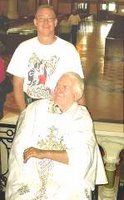 1st discreet and parochial vicar, Fr. Marion Joseph Bui, parochial vicar, Brother Mary Charles Fickel, Fr. Christopher Timoney and myself Fr. Mary Philip Wurth. Gabriel Espinoza returns to his seminary this fall. Gary Young, the volunteer who provides massage therapy to me is now also providing therapy to Sr. Celine, one of our Carmelite nuns here in San Antonio. Gary is an excellent chef who provides gourmet meals for special occasions at the shrine. He is shown here with Fr. Christoper.
1st discreet and parochial vicar, Fr. Marion Joseph Bui, parochial vicar, Brother Mary Charles Fickel, Fr. Christopher Timoney and myself Fr. Mary Philip Wurth. Gabriel Espinoza returns to his seminary this fall. Gary Young, the volunteer who provides massage therapy to me is now also providing therapy to Sr. Celine, one of our Carmelite nuns here in San Antonio. Gary is an excellent chef who provides gourmet meals for special occasions at the shrine. He is shown here with Fr. Christoper.Groundbreaking for the new St Elijah chapel will be covered in the next edition of the newsletter.
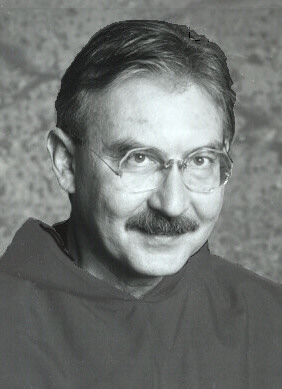

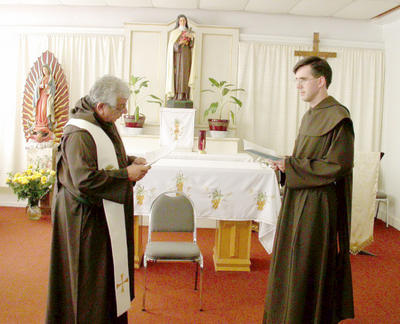 So the first order of business for the chapter on Monday night was to install Father Gregory in office. Fr. Ralph swears him in at 5:15 pm. The chapter friars then each went up, embraced him, and offered our obedience to him for the next three years. We then gathered in the upper room of our old monastery to toast our new superior. After supper, Ralph gave his state of the province report at 7:30 pm, and Gregory asked us each to write down our nominees for provincial councillors.
So the first order of business for the chapter on Monday night was to install Father Gregory in office. Fr. Ralph swears him in at 5:15 pm. The chapter friars then each went up, embraced him, and offered our obedience to him for the next three years. We then gathered in the upper room of our old monastery to toast our new superior. After supper, Ralph gave his state of the province report at 7:30 pm, and Gregory asked us each to write down our nominees for provincial councillors.





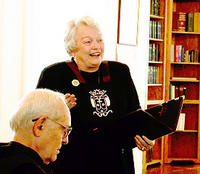






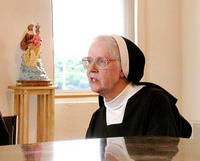



 left to right: Marion, Cecilia, Bonaventure, Sam, Mary Ann, Edi, Gregory, Ralph, Teresita, John Michael, Henry, Joseph Marie, Kateri, Raphael, Stephen, Monica, John Magdalene, Jenaro & Charles. Brothers Joseph Marie and Charles came to Oklahoma City to serve with external chores of hospitality.
left to right: Marion, Cecilia, Bonaventure, Sam, Mary Ann, Edi, Gregory, Ralph, Teresita, John Michael, Henry, Joseph Marie, Kateri, Raphael, Stephen, Monica, John Magdalene, Jenaro & Charles. Brothers Joseph Marie and Charles came to Oklahoma City to serve with external chores of hospitality.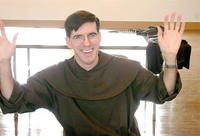






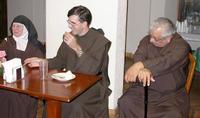 On the final night of our assembly, the Prioress of our nuns, Mother Teresita, invited us all over for supper. She was a splendid host, seen here with our new young Provincial, Father Gregory, and our old Provincial Ralph leaning on his cane. We joked with the nuns that we would stay all night, because we knew they were interested in watching a basketball game that night as the San Antonio Spurs fought for the national championship. These cloistered nuns are the Spurs biggest fans.
On the final night of our assembly, the Prioress of our nuns, Mother Teresita, invited us all over for supper. She was a splendid host, seen here with our new young Provincial, Father Gregory, and our old Provincial Ralph leaning on his cane. We joked with the nuns that we would stay all night, because we knew they were interested in watching a basketball game that night as the San Antonio Spurs fought for the national championship. These cloistered nuns are the Spurs biggest fans.